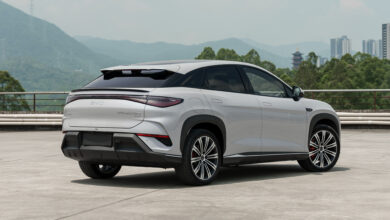A Standard Diagnostic Connector For EVs Is In The Works

[ad_1]
Over the decades, the computing power of cars has increased drastically. ICE vehicles had only mechanical methods for controlling their complex engines for a long time, but they had to switch to electronic controls to meet both the needs and wants of motorists (More power! Less fuel!) while also meeting increasingly tight emissions standards. As engine controls and the engines themselves got more and more complex, the computing needs in the rest of the vehicle also went up. Safety systems like airbags, infotainment systems, and a variety of accessories led to vehicles having not only computers, but their own networks of computers to keep it all working together well.
Emissions testing laws, starting in California and other cooperating states, required on-board diagnostics to be accessible. At first, this was done differently by different manufacturers, and you’d need to do weird things like short pins and watch a light flash, or buy a special brand-specific connector to get the data out to a computer via a COM port. Later, the OBD-II standard made it easy to not only make sure that a vehicle’s emissions were all up to snuff, but to troubleshoot a variety of other problems a car might have.
The modern resurgence of EVs kept this trend going. EVs were on the road in serious numbers long before computers, but cars already had networks of them by the time EVs came back. Plus, computer control of electric motors is a lot more efficient and comfortable than older methods.
But, the current situation with on-board diagnostics is kind of a mess. For ICE vehicles, most of the diagnostic trouble codes and access to real-time vehicle data is pretty standard. If you plug in a code reader or connect to the vehicle’s computer with a phone or computer, you can get to that information pretty quick. But, this isn’t always the case with EVs, because the PIDs and data formats can differ a lot from vehicle to vehicle.
The only reason people are able to gather so much data from them is that enthusiasts spend hundreds of hours finding the data through trial and error. For example, the Bolt EV and EUV can be accessed via an OBD-II port that GM put in the vehicle, but it took years for enthusiasts to figure out what memory addresses to access, what the data meant, and how it was formatted. Worse, the job is an ongoing process, even with people putting time in since 2017!
Newer Tesla vehicles eliminated the standard OBD-II port, as the law requiring it only applied to vehicles subject to emissions testing. It’s still possible to access the data, but you’d need an adapter and you need to find the non-standard port under the back of the center console.
But, this situation may soon change. A recent story at Jalopnik explains that work is underway to design a standard diagnostics connector for EVs.
California is proposing regulations to establish a standardized diagnostic system for electric vehicles (EVs), similar to the OBD-II system for combustion-powered cars. The new regulations aim to address this issue by covering all aspects of an EV’s propulsion system, including the battery pack, power electronics, charging system, and thermal systems, and present the data in a standard way through a standard port of some kind.
The goal isn’t emissions enforcement this time, but to provide technicians (working for manufacturers, dealers, and independent shops) with vital information for repairing EVs more effectively without having to go through a bunch of guesswork. The implementation of a standardized OBD system for EVs may involve more than just a universal port, as it requires common hardware and underlying systems for scanning and reporting faults, standard data formats, and more, so there’s a LOT of work to be done.
Even if a standard is arrived at and eventually enforced outside of ZEV states, the question of what physical port to use is going to rear its ugly head again. The OBD-II standard port is basically 1980s technology. It’s big. It’s chunky. It’s a little weird to plug into sometimes. But, it does the job, even in 2023 and has the advantage of already being in nearly every car out there.
The only thing that will keep this from becoming an ugly campaign full of politics and Stan obsession is that diagnostic plugs are not regularly used like EV charging connectors. Given that the government is involved, Tesla won’t be able to push their own design and brute force it into the market the way they did NACS, either.
So, the whole debate might not be long and complicated.
Why This Is Important
Right to repair is usually explained as an economic issue. When a car is out of warranty, not being able to repair it at independent shops means much more expensive repairs. Out of warranty cars tend to be what the poor buy, because prices are much lower, so non-repairable cars are an issue that leads to economic disparities, affecting the working poor more than everyone else who can afford to get ripped off at the dealer service department.
But, it’s also a big environmental issue. When vehicles cannot be repaired economically, they go into recycling prematurely. Not only does this rob the poor of otherwise usable transportation (and transit SUCKS in the United States), but it means that a new vehicle has to be made instead of keeping the old one on the road longer. This leads to unnecessary emissions that could have been amortized over a longer vehicle lifespan.
I get the argument that people shouldn’t be forced to get a car that barely runs, but the need for better transit and micromobility infrastructure doesn’t override the need for justice in vehicle repair. Having a reliable fleet that serves the needs of the citizenry is an important issue in economic health, making it a matter of interstate commerce. This means there’s a good argument for mandating this at the federal level, not only to keep commerce regular, but to keep monopolies from forming.
In other words, a free market has to be kept free sometimes. Having undecipherable and expensive diagnostic work required on different brands of vehicle is a major impediment to competition and property rights, so it’s something that shouldn’t be tolerated.
Featured image by Jennifer Sensiba.
Have a tip for CleanTechnica? Want to advertise? Want to suggest a guest for our CleanTech Talk podcast? Contact us here.
EV Obsession Daily!
https://www.youtube.com/watch?v=videoseries
I don’t like paywalls. You don’t like paywalls. Who likes paywalls? Here at CleanTechnica, we implemented a limited paywall for a while, but it always felt wrong — and it was always tough to decide what we should put behind there. In theory, your most exclusive and best content goes behind a paywall. But then fewer people read it!! So, we’ve decided to completely nix paywalls here at CleanTechnica. But…
Thank you!
Iontra: “Thinking Outside the Battery”
CleanTechnica uses affiliate links. See our policy here.
[ad_2]






